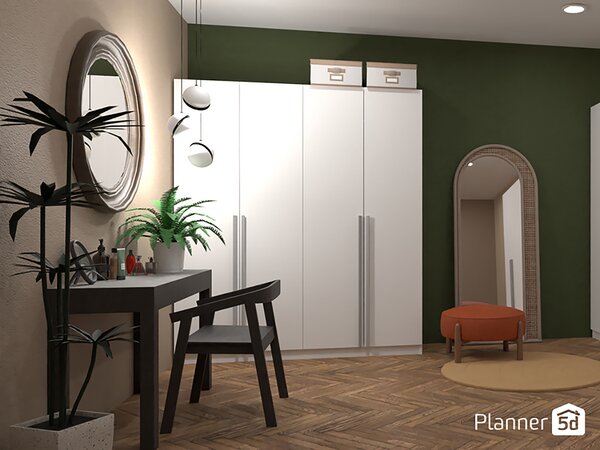As generative AI tools rapidly develop, machine-learning technology is coming for our houses.
On the front page of online furniture shopping service ToTree.co’s website, I’m met with the message "Furniture Picked For You" above a prompt to start my own project. What follows is a survey with questions like, "What sort of place are we working with?"—house, apartment/condo/co-op, or other (with a drawing of a sailboat)—and a few inquiries about my timeline and budget. Next, there’s a "pick your favorite style" section where I’m asked to rank interior layouts and furniture options based on my design preferences.
For $149, and within 72 hours, ToTree says I’ll receive two virtual style boards with personalized furniture recommendations from the service’s partnering brands like BluDot, Article, and Room & Board, generated using machine-learning algorithms, and a dedicated Living Space specialist (a real human consultant who can offer guidance for tasks like measuring spaces and assist with finding additional decor options or arranging necessary returns).

Courtesy of Ikea Kreativ
ToTree isn’t alone in the virtual interior design space: The free Houzz app also follows an e-commerce model driven by algorithms, and Ikea’s free "digital design experience" allows users to shop 3-D showrooms and place the brand’s furniture in realistic versions of their own spaces. Other virtual design tools like Planner 5D allow users to create realistic interior mockups pulling from a user-generated library of furnishings, paint colors, and materials. DecorMatters uses artificial intelligence (AI) and augmented reality (AR) technology to generate product recommendations and virtual depictions of furniture and decor in users’ homes.
Then, there are a slew of AI-powered platforms that take it a step further. Rapidly emerging text-to-image AI tools like Midjourney, Dall-E, and Stable Diffusion can dream up interior design plans based on written language descriptions. Some users have leveraged Google Lens’s image recognition technology to track down furnishings that look similar to their AI-generated mockups. While there is some trepidation around this technology eliminating design jobs of all kinds, a number of designers are actually utilizing generative AI to their advantage.

Courtesy of Planner5D
Danny Wang, founder of the namesake Los Angeles design-build firm, for example, uses Midjourney and Dall-E to quickly concept and create visual mockups for his clients. He also taps ChatGPT, a breakthrough AI chatbot (short for "generative pre-trained transformer"), to draft routine emails. "If you’re not using the tool and you’re taking two to three days to design a room, where this AI is conceptualized in two to five minutes, you’re gonna get left behind," he says. Wang says the AI platforms substantially speed up his process by replacing low- to mid-level design tasks. For designers, homeowners, and renters alike, sometimes speed and ease are top priorities.
While using an AI-driven tool can be a great, fast fix for design projects—and newer generative AI tools can increasingly produce renderings and images with shocking human precision—the platforms are far from foolproof. "I think people want to have human connection, and it takes away [from that], especially a job that is so intimate and personal," says Victoria Adesanmi, founder and principal of Aesthetics Studios in Los Angeles. "Technology can’t do everything."
Wang points to the difference that would result from inputting the prompt, I want a black kitchen, versus, I want a black kitchen with shaker cabinets and brass hardware, into an AI-driven platform. "If I don’t have [design] experience and I just rely on the algorithm, it will just make a pretty common design," he says. "AI raises the floor of design, but doesn’t really push the ceiling."
Despite the rapid advancement and increasing popularity of generative AI-driven tools across industries, there are also concerns about the widespread use of the technology, like job replacement, weakened cybersecurity, and algorithmic bias and homogeneity. For design, the latter is potentially risky. "A dangerous part of [using AI-powered design platforms] is if people become reliant, everything is going to look the same," says Adesanmi. "But then it makes me think, what’s the difference between that and Instagram, right? Because everyone’s going to Instagram for inspiration, whether it’s for fashion or home."
Still, AI-powered design platforms—both free and fixed-rate services—do expand a certain level of access. "I think that’s probably the biggest thing, because not everyone can hire a designer," Adesanmi says. Notably, not everyone has the resources (or desire) to become a designer, either—but with these tools, they can interact at varying levels with the creative process. Mikhail Budhai, founder of Studio Liguanea, which specializes in industrial design and product development, likens this to the impact of the iPhone on photography. "It didn’t necessarily make photography as a medium worse," he says. "It may have empowered photographers who just had an iPhone and didn’t have all the tools to look deeper for talent they didn’t realize they had."
For now, generative AI is mostly being used by designers and curious users for inspiration and experimentation. "It’s not perfect, but every version comes out leaps and bounds better," Wang says. Algorithms can technically help decorate your space, but the learnings and creativity actual designers bring to the table isn’t something that can be replicated by a machine. And ultimately, all generative AI creations pull from existing human output. There’s no AI without a human to learn from—for the time being.
Top photo by gremlin / E+ / Getty.
Related Reading:
You Can Build Anything in the Metaverse, Especially a Déjà Vu-Inducing, Unlivable House
The Researcher Behind HouseZero Brings Us Closer to AI-Powered, Self-Regulating Homes
How Will Architecture Merge the Digital and Physical Worlds?
Read More
By: Rae Witte
Title: Can an Algorithm Furnish Your Home?
Sourced From: www.dwell.com/article/can-an-algorithm-furnish-your-home-72a65735
Published Date: Tue, 25 Apr 2023 15:44:24 GMT
.png)





